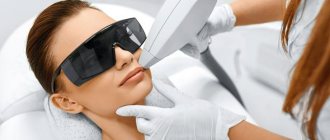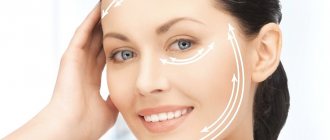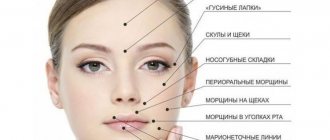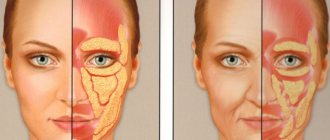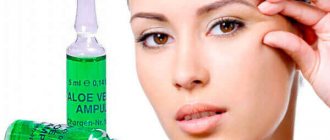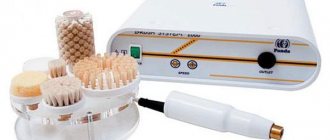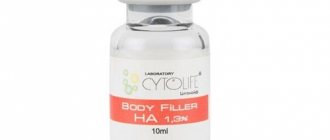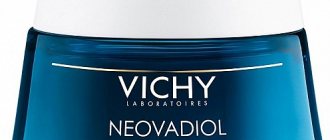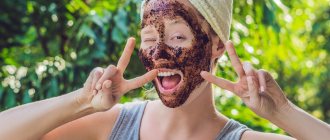I am 65 years old. I work as a teacher and have a large circle of friends. And as an active person, I naturally want to look as well-groomed as possible and at least a little younger than my age. However, I am not ready to resort to radical surgical interventions; I have a great prejudice towards them. Therefore, with interest and hope, I agreed to test on myself a procedure for tightening and restoring the elasticity of the skin of the face and neck called “Dermotonia using the French device DermoV4” (registration certificate No. FSZ 2007/00354 dated November 6, 2007).
Facial dermotonia
Dermotony is a unique technique that is based on a reflex-vacuum effect on the facial skin.
Just one facial dermotony procedure is comparable in effectiveness to seven manual massage procedures. From this we can correctly conclude that the desired results can also be achieved 7 times faster.
The procedure increases the firmness and elasticity of the skin, accelerates metabolic processes, eliminates puffiness, strengthens facial muscles, removes toxins, smoothes out shallow wrinkles, and activates lymphatic circulation.
One of the advantages of facial dermotonia is that it has a lasting result and there are no side effects.
The best thing is that the procedure has an excellent relaxing character: during dermotonia of the face, the muscles relax, fatigue goes away and tension is relieved.
Help
The dermotony method was proposed in 1995 by physician Serge Karagozian, one of the developers of LPG devices and the endermology method.
The dermotony technique is based on a new lifting philosophy, where the skin is considered not as a protective shell covering the human body, but as an organ that functions in unity with the entire body, so any problem inside is reflected, as on a screen, outside.
Dermotonia is a vacuum-reflex therapy, during which there is an impact on reflex zones, the so-called Zakharyin-Ged zones (areas on the skin in which, in diseases of the internal organs, reflected pain often appears, as well as changes in sensitivity in the form of pain and temperature hyperesthesia) , and to the lymph nodes.
Dermotonia can be considered as a cross between manual and hardware massage: during the procedure, continuous contact of the doctor’s hands with the patient’s skin is maintained and at the same time a vibration-mechanical-vacuum hardware effect is performed.
Dermotonia does not imply any seasonality. It can be performed regularly, and, in fact, it has a small list of contraindications:
- disorders of the cardiovascular system (stage II–IV hypertension, thrombophlebitis, capillary fragility, coronary artery disease);
- pathologies of the musculoskeletal system (exacerbation of rheumatoid arthritis, etc.);
- tumor-like formations (associated with cancer);
- skin disorders (dermatoses, fungal diseases, etc.);
- inflammatory processes (acute respiratory infections, acute respiratory viral infections, fever);
- pregnancy (after the 6th month);
- diabetes;
- epilepsy.
Before the start of the course of procedures , leading methodologist, dermatologist-cosmetologist Tatyana Kleiman collected anamnesis and spoke in detail about contraindications.
Then the doctor began manual diagnostics of the facial skin to assess the consistency of the skin and identify problem areas. Having completed the analytical palpation, the cosmetologist said that we would get rid of gravitational ptosis (drooping of the oval of the face), focusing on the area of the chin, where the so-called “jowls” are formed, and the area around the mouth, where purse-string wrinkles bother me (affected by professional activities ). In addition, the specialist was going to work on the area near the ears and correct the sternocleidomastoid muscle, which many people at my age have a problem with.
During this, to be honest, unusual examination, I asked Tatyana Kleiman a lot of questions about the diagnostic technique. According to the doctor, to carry out the dermotonia procedure, she must identify four types of zones:
- zones of dermodystonia (dermo - skin, dystonia - disorder) - these are areas of circulatory disorders with severe swelling, skin folds that are difficult to grip;
- dermalgia zones (dermis - skin, pain - pain) are areas of poor circulation, actually painful areas of the skin in which metabolism is disturbed (most often these are classic problem areas in women: riding breeches, the lateral surfaces of the arms in the shoulder area, places where cellulite is localized) ;
- zones of “energy barriers” - this is dermodystonia in the zone of biologically active points (projections of organs), this zone can also be called a zone of circulatory disorders;
- Scar zones are areas where blood circulation is impaired due to fibrosis - the formation of denser collagen.
As a result, after all the research, an individual program was drawn up for me, which consisted of five dermotonia procedures twice a week.
The dermotony procedure itself was carried out in several stages.
They put a cap on my head to prevent hair from getting into the treatment area, cleansed my skin and explained that the procedure is carried out on dry skin, without using any cream or gel, which reduces the likelihood of allergic reactions to zero (for those patients who need body services, the use of a protective suit is not required).
For the procedure, the doctor chose a miniature vacuum attachment M5, and the work began to boil.
The first stage was drainage of the lymph nodes using the pulsating mode of the device. According to the doctor, the following were drained:
- supraclavicular lymph nodes;
- nodes at the posterior surface of the sternocleidomastoid muscle;
- submandibular lymph nodes;
- postauricular lymph nodes;
- anterior auricular lymph nodes.
Next, the doctor changed the nozzle to a conical one and, still in the same mode of the device, worked on the areas of dermalgia and dermodystonia (in my case it was the cheeks, neck and chin). Interestingly, the movements resembled triangles.
Next, having again changed the attachment to a ball one, Tatyana Kleiman moved on to linear lymphatic drainage of the entire face and neck, as well as the area around the eyes, using the constant mode of the device. The feeling was very pleasant. And according to the doctor’s explanations, she performed the movements themselves slowly, in the direction of the lymph nodes, where they were fixed. The doctor specifically noted that this is very important, otherwise the procedure will be incomplete.
At the end of the service, the first stage was repeated with the same nozzle.
This is how the first and second visits to the doctor went. For the third time, the protocol changed: two more stages were added: depressomassage on the constant mode of the device using a ball nozzle (it was performed with both linear and circular movements) and treatment of wrinkles, also on the constant mode of the device, which was carried out perpendicular to them.
When I asked Tatyana Kleiman a question: why is this massage technique better than the usual manual one? – she explained that the skin, together with the subcutaneous fatty tissue, is not “pressed” inward, as with a regular massage, but is lifted up by the manipule, thus opening previously inactive vessels, while the rounded shape of the nozzle allows them not to be injured. In addition, changing the modes of all four stages of the procedure is real gymnastics for tissues, the circulatory system and internal organs. In fact, the device’s manipulators worked on my “dormant” fibroblasts, which again began to produce collagen and elastin (at least, I really hope so).
Tatyana Kleiman said that very often this reflex-vacuum procedure is called a prototype of cupping massage, although this is not entirely correct. Dermotonia is a physiological method. And its fundamental difference from vacuum massage is the presence of a pulsating mode at a unique frequency of 0.6–0.7 Hz, that is, at the heart rate, so the whole body responds well to this procedure.
In addition, the doctor noted that dermotonia makes it possible to select individual vacuum intensity: the depth of exposure can be controlled depending on the characteristics of the soft tissues.
The essence and features of the technology
The operating principle of RF lifting is the targeted use of electromagnetic pulses for thermal stimulation of connective tissues and the launch of natural processes of neocollagenesis.
Deep heating provokes the active division of fibroblasts, which triggers the production of elastin and collagen - natural “building materials” necessary for the formation of a healthy skin matrix. Under the influence of high temperatures, long and stretched collagen fibers contract, which provides an instant lifting effect.
This process is accompanied by powerful natural biochemical reactions:
- stimulation of cellular metabolism;
- normalization of metabolism in tissues;
- removing toxins and metabolic products from cells and intercellular space.
As a result of RF lifting, the color and texture of the skin are evened out, and its turgor increases. The skin becomes more elastic to the touch and takes on a healthy, toned appearance. The effect is noticeable immediately after the manipulation and only increases over time due to the ongoing regeneration processes.
Before starting a therapeutic course, the patient attends an initial consultation with a doctor. The specialist clarifies the absence of contraindications to radiofrequency lifting and plans the optimal number of sessions depending on individual parameters and the condition of the skin. The cosmetologist also explains how the procedure is done, how radio wave radiation works, how rehabilitation works, and when you can return to your normal rhythm of life.
Indications
Another advantage of dermotonia
– it helps eliminate stretch marks, as well as eliminate scars and scars.
After the procedures, pain disappears, and skin tension in the problem area returns to normal. The technique also helps in the fight against tissue swelling and puffiness, that is, it helps to defeat annoying dark circles and bags under the eyes. Dermotonia is
used for facial correction, namely, to eliminate nasolabial and eyebrow folds, and a double chin. Thanks to the draining and regenerating effect, skin tone increases and elasticity is restored. Use of dermotonia in medicine.
Dermotonia
used not only in cosmetology, but also in medicine. For example, vacuum reflexology is used when preparing the skin for plastic surgery, for example, transplantation. After surgery, dermotony can also be effective in eliminating swelling, scarring, and hemorrhage. The technique can be included in a course of procedures to combat vertebral dysfunctions, arthrosis, pathological tendon problems, and helps normalize the functions of the lumbosacral spine. As a result of using dermotonia, inflammation is relieved, pain goes away, and swelling disappears. The technique is also used in traumatology (treatment of sprains, dislocations, hematomas, fibrosis), phlebology (combat chronic pathologies of the venous-lymphatic system, normalize the functioning of vascular valves), neurology (elimination of neurovegetative dysfunctions of the body).
Benefits of the procedure at Trinity
Trinity Personal Cosmetology Clinic offers innovative radiofrequency lifting technologies and a soft, prolonged effect without pain.
The list of advantages of the RF lifting technique:
- the possibility of tightening, rejuvenating and healing the skin without surgery;
- no risk of damage or infection of the skin;
- high efficiency of RF lifting;
- painlessness;
- short rehabilitation period.
We guarantee high quality cosmetology services, reasonable prices and individual selection of antiage programs. And also the experience of certified specialists who know everything about how to work with RF lifting.
Contraindications
The revolutionary RF lifting technology is a controlled and guaranteed safe procedure that gives a predicted result. But there are some contraindications for which exposure to radiofrequency pulses is not recommended:
- pregnancy and lactation;
- malignant and benign neoplasms in the treatment area;
- oncological processes;
- autoimmune diseases;
- acute bacterial and viral infections;
- chronic pathologies in the acute stage;
- damage and inflammatory processes in the affected area.
Radio wave therapy should be replaced with another procedure if there are metal implants in the treatment area, or if the patient has implanted electronic devices (defibrillators, pacemakers).
Cost of the procedure
The price of dermotonia depends on the area of the body to which it will be applied and the pricing of the clinic. Region and city are also important.
For the facial area, the price for one procedure in large cities starts from 1000 rubles. A course consisting of 10 procedures will cost 10,000 respectively. But, some clinics give discounts to their regular customers and give one procedure as a gift.
The cost of dermotonia for the whole body starts from 2500 rubles in large cities. The procedure is aimed at removing swelling and lymphatic drainage. If you turn on the rejuvenation effect, the cost increases by 1000 rubles. The course costs from 18,000 rubles.
